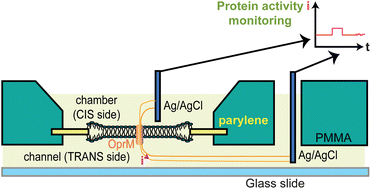This paper describes the fabrication and use of a biomimetic microfluidic device for the monitoring of a functional porin reconstituted within a miniaturized suspended artificial bilayer lipid membrane (BLM). Such a microfluidic device allows for (1) fluidic and electrical access to both sides of the BLM and (2) reproducible membrane protein insertion and long-term electrical monitoring of its conductance (Gi), thanks to the miniaturization of the BLM. We demonstrate here for the first time the feasibility to insert a large trans-membrane protein through its β-barrel, and monitor its functional activity for more than 1 hour (limited by buffer evaporation). In this paper, we specifically used our device for the monitoring of OprM, a bacterial efflux channel involved in the multidrug resistance of the bacteria Pseudomonas aeruginosa. Sub-steps of the OprM channel conductance were detected during the electrical recordings within our device, which might be due to oscillations between several structural conformations (sub-states) adopted by the protein, as part of its opening mechanism. This work is a first step towards the establishment of a genuine platform dedicated to the investigation of bacterial proteins under reconstituted conditions, a very promising tool for the screening of new inhibitors against bacterial channels involved in drug resistance.

You have access to this article
 Please wait while we load your content...
Something went wrong. Try again?
Please wait while we load your content...
Something went wrong. Try again?


 Please wait while we load your content...
Please wait while we load your content...